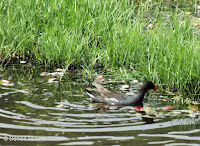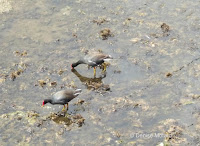HAWAIIAN GALLINULE
HAWAIIAN GALLINULE (Gallinula galeata sandvicensis) – ‘Alae ‘Ula – (See images below)
DESCRIPTION: The Hawaiian Gallinule is generally black, with a little bit of white on the wings and tail underside. The bird has a red bill with a yellow tip, and a red frontal shield. The legs are green-yellow except for red near the belly. The feet are large like those of hens. Sexes are similar. Juveniles lack the frontal shield. It is about one foot long (30 cm).
VOICE: https://www.xeno-canto.org/explore?query=Gallinula+galeata+sandvicensis
NAME: The English name ‘Gallinule’ means ‘little hen’ in Latin. As for the Latin species name ‘galeata’, it means ‘helmet’, in reference to the bird’s frontal shield. The Latin word ‘sandvicensis’ for the subspecies refers to the name given to the Hawaiian Islands by explorer James Cook, the Sandwich Islands. So whenever you see this word in the Latin name of a species, it means it is endemic to Hawaii.
HABITAT: Shallow wetlands such as marshes, with dense emergent vegetation.
DIET: These birds eat vegetation and invertebrates in fresh water marshlands, ponds and rice fields.
NESTING: The Hawaiian gallinule builds a nest on floating dense vegetation. An average of six grey eggs are laid, which are incubated by both parents. They also both care for the chicks, which can walk and swim not long after hatching.
DISTRIBUTION: Mostly Kauai and Oahu. Endemic to Hawaii.
CONSERVATION: The Hawaiian gallinule is endangered due to loss of habitat and predation by introduced mammals, such as rats, dogs, mongoose and cats, and some birds such as the Cattle Egret
NOTES: In spite of spending most of their life on wetlands, the feet of the common gallinule look more like those of hens, although they have evolved to allow for good swimming.
This bird is in the same family as the Hawaiian Coot, but the Hawaiian gallinule is harder to observe, preferring to hide in the marsh grasses.
SIMILAR SPECIES: Common Gallinule, Hawaiian Coot – The endangered Hawaiian gallinule (Gallinula galeata sandvicensis) is a subspecies of the common gallinule that is endemic to Hawaii. Compare the photos below of the Common gallinule and the Hawaiian gallinule.
REFERENCES: Fact sheet from Hawaii Department of Land and Natural Resources: Hawaiian Moorhen – Hawaii DLNR – Oct. 2005
https://en.wikipedia.org/wiki/Hawaiian_gallinule
https://americanornithologypubsblog.org/2018/10/24/homebody-tendencies-put-hawaiian-gallinules-at-risk/
https://abcbirds.org/bird/hawaiian-common-gallinule
https://identify.whatbird.com/obj/1183/_/Hawaiian_Moorhen.aspx
Here are some short videos of the Hawaiian gallinule (mainly) taken at the Hamakua Marsh access point in Kailua, both from the parking lot and from the bridge. The first video shows both a Hawaiian gallinule and a Hawaiian coot (toward the end) foraging in very shallow water near a bridge:
This video shows a Hawaiian gallinule rushing for cover at the near presence of a Black-crowned Night Heron (to the left). The latter prey on the former.
Even in the absence of webbed feet, Hawaiian gallinules can swim relatively fast when needed:
Self-preening is crucial for healthy feathers:
This short clip shows the white undertail coverts of the Hawaiian Gallinule:
DESCRIPTION: The Hawaiian Gallinule is generally black, with a little bit of white on the wings and tail underside. The bird has a red bill with a yellow tip, and a red frontal shield. The legs are green-yellow except for red near the belly. The feet are large like those of hens. Sexes are similar. Juveniles lack the frontal shield. It is about one foot long (30 cm).
VOICE: https://www.xeno-canto.org/explore?query=Gallinula+galeata+sandvicensis
NAME: The English name ‘Gallinule’ means ‘little hen’ in Latin. As for the Latin species name ‘galeata’, it means ‘helmet’, in reference to the bird’s frontal shield. The Latin word ‘sandvicensis’ for the subspecies refers to the name given to the Hawaiian Islands by explorer James Cook, the Sandwich Islands. So whenever you see this word in the Latin name of a species, it means it is endemic to Hawaii.
HABITAT: Shallow wetlands such as marshes, with dense emergent vegetation.
DIET: These birds eat vegetation and invertebrates in fresh water marshlands, ponds and rice fields.
NESTING: The Hawaiian gallinule builds a nest on floating dense vegetation. An average of six grey eggs are laid, which are incubated by both parents. They also both care for the chicks, which can walk and swim not long after hatching.
DISTRIBUTION: Mostly Kauai and Oahu. Endemic to Hawaii.
CONSERVATION: The Hawaiian gallinule is endangered due to loss of habitat and predation by introduced mammals, such as rats, dogs, mongoose and cats, and some birds such as the Cattle Egret
NOTES: In spite of spending most of their life on wetlands, the feet of the common gallinule look more like those of hens, although they have evolved to allow for good swimming.
This bird is in the same family as the Hawaiian Coot, but the Hawaiian gallinule is harder to observe, preferring to hide in the marsh grasses.
SIMILAR SPECIES: Common Gallinule, Hawaiian Coot – The endangered Hawaiian gallinule (Gallinula galeata sandvicensis) is a subspecies of the common gallinule that is endemic to Hawaii. Compare the photos below of the Common gallinule and the Hawaiian gallinule.
REFERENCES: Fact sheet from Hawaii Department of Land and Natural Resources: Hawaiian Moorhen – Hawaii DLNR – Oct. 2005
https://en.wikipedia.org/wiki/Hawaiian_gallinule
https://americanornithologypubsblog.org/2018/10/24/homebody-tendencies-put-hawaiian-gallinules-at-risk/
https://abcbirds.org/bird/hawaiian-common-gallinule
https://identify.whatbird.com/obj/1183/_/Hawaiian_Moorhen.aspx
 |
| Hawaiian gallinule, Hamakua Marsh |
 |
| Hawaiian gallinule family, Kailua |
 |
| Protecting sign, Oahu |
 |
| Hawaiian gallinule in water, Kailua |
 |
| Hawaiian gallinules foraging, Kailua |
 |
| Hawaiian gallinules, Hamakua Marsh |
 |
| Hawaiian gallinule, TX, USGS, Sept. 2005 |
This video shows a Hawaiian gallinule rushing for cover at the near presence of a Black-crowned Night Heron (to the left). The latter prey on the former.
Even in the absence of webbed feet, Hawaiian gallinules can swim relatively fast when needed:
Self-preening is crucial for healthy feathers:
This short clip shows the white undertail coverts of the Hawaiian Gallinule: